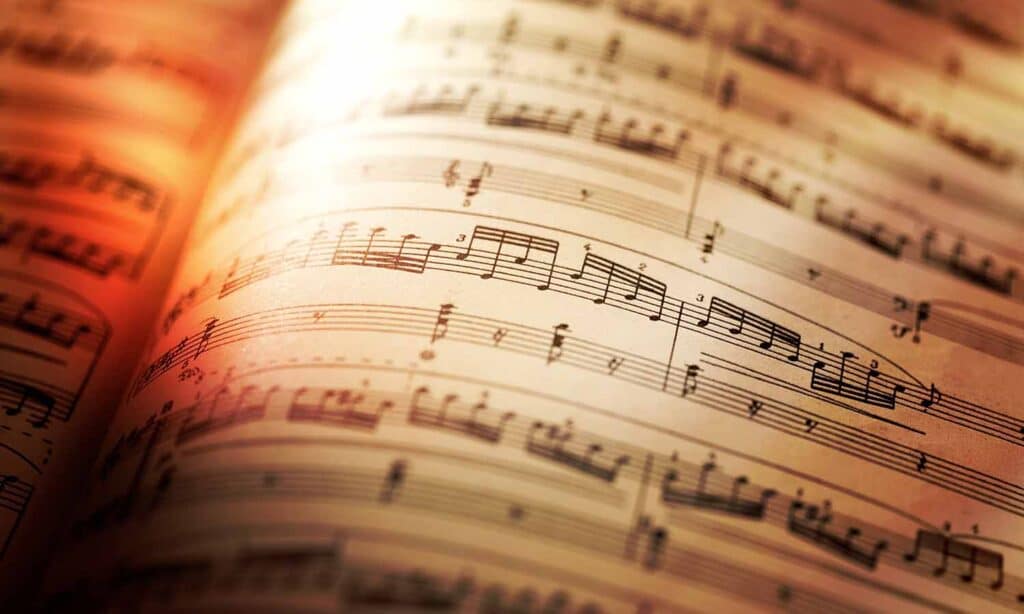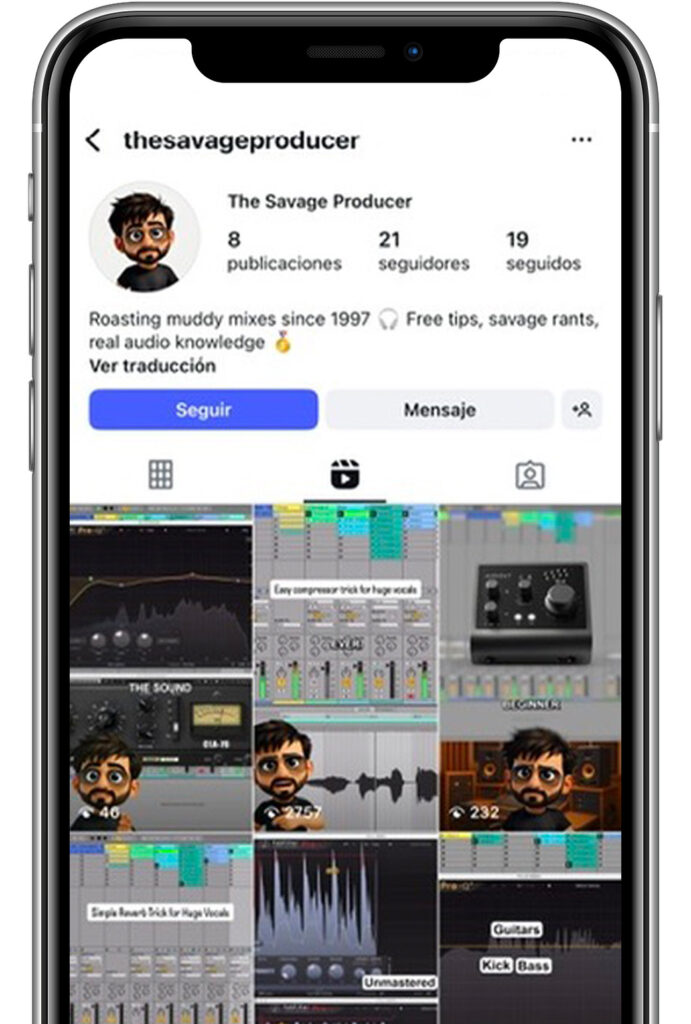We humans have been playing and enjoying music for as long as we can remember. But at some point, people realised that they needed to develop a kind of "language" to write down musical ideas and have them interpreted by other people.
Musical signs or symbols are graphic representations that you can use to write and read music. Each musical sign has a specific function - a "command" or "instruction" to the musician who is reading it.
Advertisement
Nowadays, musical pieces are mostly written via MIDI, but musical signs have been used since the VIII century.
The document in which the various musical signs are written is called a "score"; and the score consists of several "staves" (or staves). Musical signs or symbols are placed on the staff.
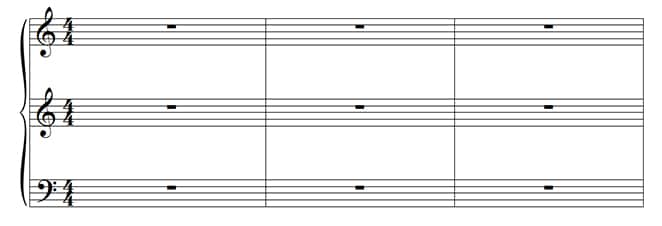
The staff is a pattern of five horizontal lines running parallel and equally spaced. It was agreed to count the lines from the bottom to the top: The lowest line is the first and the top line is the fifth.
The spaces between the lines are called spaces and are also counted from bottom to top. The staff then consists of five lines and four spaces, in which the characters for writing the notes are placed.
The staff could well be compared to the piano roll of your DAW !
Also interesting:
- The 8 best audio interfaces for music producers
- The 9 Best MIDI Keyboards in 2023
- The 11 best headphones for music production
Classification of the musical signs
Clef
The clefs are musical signs written at the beginning of the staff. They are used to specify the name of the notes on the staff and at the same time to indicate the position they should occupy in the general scale.
The best known and most frequently used key is the Treble clef.
The general scale is the union of all notes, from the lowest to the highest, that can be played by voices or instruments.

There are three clefs used in modern music:
- The bass clef, which is on the third, fourth or fifth line of the staff.
- The C clef, which is on the first, second, third, and fourth lines of the staff.
- The G clef, which is on the first and second lines of the staff.
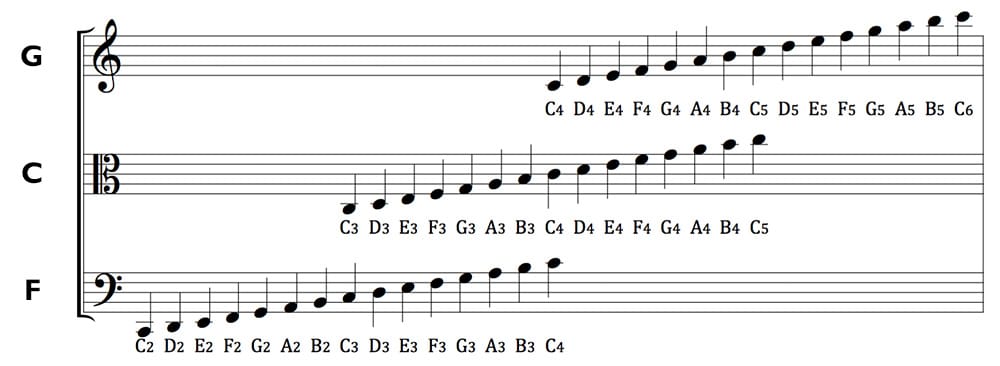
The clefs give their names to the notes that are on the same lines they occupy.
Note value
➔ Click here for the detailed article on musical note values
In music, the note value is a sign that graphically represents the musical duration of a particular note in a piece of music. The relative duration of a note is graphically represented by the colour or shape of the note head, the presence or absence of the note stem and the presence or absence of hooked brackets.
The most frequently used figures are seven and are designated as graphic elements of music as follows: Whole note, Half note, Quarter note, Eighth note, Sixteenth note and Thirty-second note.

There are seven main musical figures, ordered from largest to smallest:
- Whole note, marks four strokes (4).
- Half note, two strokes (2).
- Quarter note, one stroke (1).
- The eighth note, half a beat (1/2).
- Sixteenth note, beats a quarter of a beat (1/4).
- Thirty-second note, one eighth of a beat (1/8).
- Sixty-fourth notes marks one on sixteenth of a beat (1/16).
Accidentals
Accidentals or accidentals are the signs in music that change the intonation (or pitch) of natural and altered sounds. The most common accidentals are the Sharp, the b and Dissolution sign.

There are a total of 5 such musical signs:
- The Sharp. Raises the intonation of the note by half a tone.
- The Double cross. Raises the intonation of the note twice as much as the simple cross.
- The b. Decreases the intonation of the note by half a tone.
- The Double b. Lowers the intonation of the note twice as much as the simple E-flat.
- The Dissolution sign. Destroys the effect of sharp and flat. It lowers the tone that raised the cross and raises the tone that lowered the b.
Also interesting: The 13 best electric guitars for beginners and pros
Key Signature
The key signature is represented by accidentals at the beginning of the score in a certain order. They change the corresponding notes in a piece of music with the same name.
Key signatures always appear in a certain order depending on whether they are bs or sharps. The order of the bs is the reverse order of the sharps and vice versa. The spacing is always a Fifth.
Order of the bs:
B♭ - E♭ - A♭ - D♭ - G♭ - C♭ - F♭ „B♭attle Ends And Down Goes Charles' Father"
Order of the sharps:
F♯ - C♯ - G♯ - D♯ - A♯ - E♯ - B♯ „Father Charles Goes Down And Ends B♭attle.
Courtesy accidentals
Courtesy accidentals or cautionary accidentals are accidentals that are unnecessary but are placed to avoid reading errors. At present, the bar line is considered to cancel the effect of a dislocation mark (except in the case of indistinct notes). However, when the same note appears in the next bar, editors often use the accidental as a reminder of the correct pitch of that note. The use of accidentals varies, but is considered obligatory in certain situations, such as the following:
- When the first note of a bar is affected by a change made in the previous bar. If, after a slur that carries the effect of the accidental over the bar, the same note reappears in the next bar.
- There are other uses, but they are not used constantly. Warning accidentals are sometimes placed in parentheses to emphasise their reminiscent nature. Complimentary accidentals can be used to clarify ambiguities, but should be kept to a minimum.
Bar
The time signature is a metrical musical unit consisting of several time units (musical figures) organized into groups in which there is a contrast between accented and unaccented parts.
Time signatures can be classified according to various criteria. Binary, ternary and quaternary time signatures are distinguished according to the number of beats they consist of. On the other hand, depending on the binary or ternary subdivision of each beat, there are simple bars (or bars with binary subdivisions) as opposed to compound bars (or bars with ternary subdivisions).
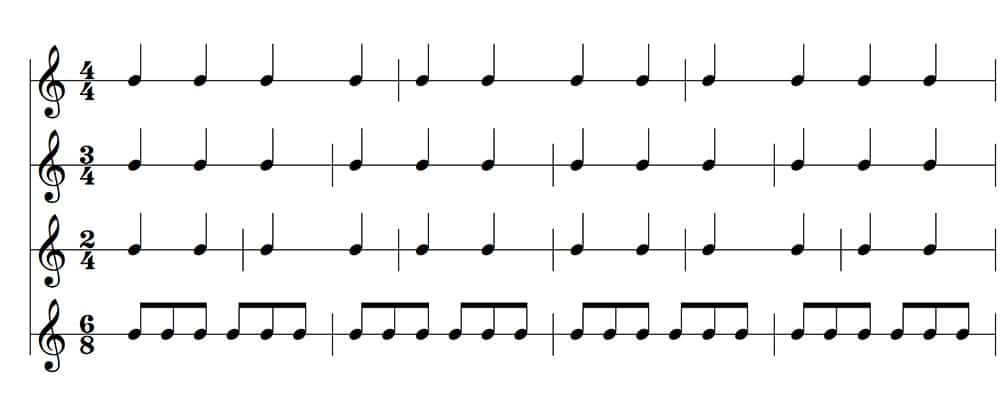
The graphic representation of the time signature is given by the time signature number, a convention used in Western music notation to indicate how many beats each bar has and which musical figure defines a beat.
In sheet music, bars are placed at the beginning of the staff of the work or after a double bar to indicate a bar change. The subdivision into bars is represented by vertical lines called bar lines or bar lines, which are perpendicular to the staves.
The set of values, notes or rests that lie between two dividing lines form a bar. The sum of these values must be the same for all bars that make up a piece of music and therefore all bars must be the same length.
Repeat sign
In music, a repeat sign is a sign indicating that a section is to be repeated. If the piece has a single repeat sign, it means that it is to be repeated from the beginning and then continues (or ends, if the sign appears at the end of the piece).
The same musical sign, but in the opposite direction, indicates the place where the repetition is to begin. These are similar to the indications da capo and dal segno.
These signs help to save space in the score, as one or more bars are often repeated.
Tie
A tie is a character that connects two notes of the same tone, even if they are of different lengths. This character indicates that the value of the second note is added to the value of the first one.

The tie is essential to obtain durations that cannot be written with other characters.
Rest
In music, a rest is a symbol that graphically represents the duration of a particular silence in a piece of music. The graphic representation of the relative duration of a rest is done by a series of different symbols whose properties are changed, e.g. their position on the staff or the number of ticks they have.
When a pause appears on the staff, it means that we should not play that part.
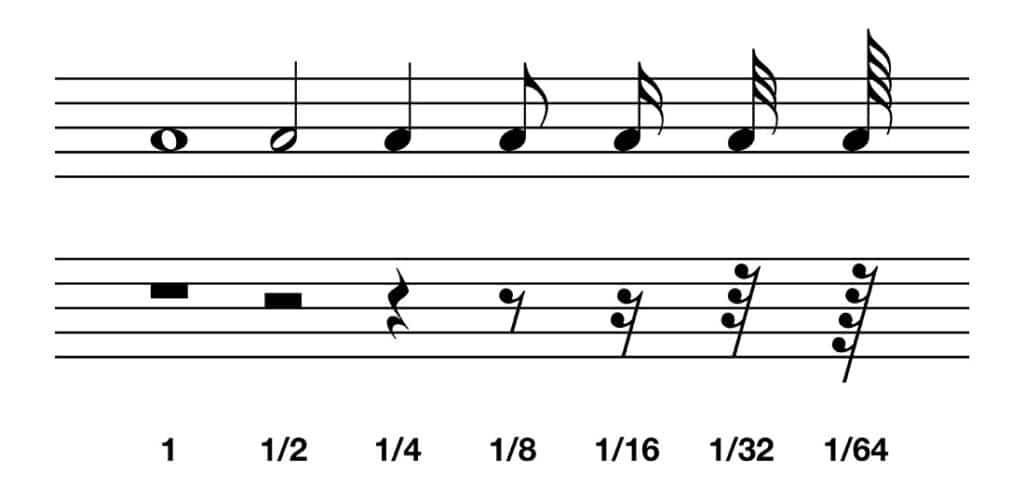
There are seven figures of silence, they express the more or less long duration of the absence of sound:
- Whole rest
- Half rest
- Quarter rest
- Eighth rest
- Sixteenth rest
- Thirty-second rest
- Sixty-fourth rest
Fermata
In musical notation, it is a sign that indicates a rest point and extends the duration of the musical figures it affects. That is, this prolongation interrupts the bar that has been played up to that moment, and the affected note, rest or bar must be held longer than indicated in the score.
Exactly how long the time is extended is at the discretion of the performer or conductor, although it is common to double the duration.
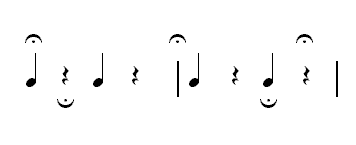
In the aria da capo it is the sign marking the end of the first part ("fine"). And in solo concertos it marks the so-called cadenzas, which are dedicated to the soloist's improvisation.
Syncopation
Syncopation in music is a compositional strategy that interrupts the regularity of the rhythm in some way by emphasising a note at a weak or semi-strong point in a bar.
| It can be written with notes that go beyond the strong beat of the bar: | 
Syncopation of quarter and eighth notes |
| It can be written with pauses (in this case it is called a contratiempo). If the instrument playing the rhythm does not produce sustained notes, it sounds the same as if written with numbers: | 
Syncopation of pauses |
| If the instrument produces long-drawn notes, you get the same rhythm when you play the syncopation written with slurs: | 
Syncopation through long drawn out tones |
Note divisions: Duole, triplet, quarto, quintole...
Special value groups, artificial groups, irregular values or simply note divisions are, in music, groups of notes that have a different duration (longer or shorter) than that which they represent as a natural group.
In principle, any kind of division of the rhythmic unit is possible as long as it is derived from already existing figures. This is called natural division.
On the contrary, if the division is done with the help of numbers that are not derived from the usual numbers but from artificial groups, it is called artificial division.
The most commonly used note division in modern music is the triplet, a special note division consisting of three equal numbers played at the time when only two should be played, although this is not necessarily the case, as two notes such as a quarter note and an eighth note can also be combined into a triplet.
They are usually notated by placing a bar with the number 3 above it. The triplet is a group with special appreciation through reduction, because three in the time of two means that its numbers are necessarily faster. The triplet is usually used to achieve compound metre (the measure units of the bar are grouped into threes) or simple metre (the measure units of the bar are grouped into twos).
High and low octave
These musical signs help us to determine the pitch of the desired notes on the staff.
For very high notes, the staff is sometimes not enough; more lines can be set, but this makes the musical reading more complicated. So we use symbols in the low octave that allow us to interpret it as a high octave.
Brackets with the designations 8vb (ital. ottava bassa: 'low octave'.) and 8va (Ital. ottava alta: 'high octave'.) indicate that the note should sound an octave lower or higher than notated.

Trill
The trill is a "musical ornament" consisting of two quickly alternating notes. The root note and the next note in the scale must be repeated as quickly as possible.
The trill is designated with the letters tr. and consists of three parts: the preparation, the beat and the end.

The trill should always be played very evenly; bright in fast passages and soft in slow passages.
Arpeggio
The arpeggio (from the Italian arpeggio, a derivative of the word harp) is a sign that precedes a chord; it indicates that the notes of the chord should be struck in rapid succession, starting with the lowest note.
The notes are not played simultaneously, but one after the other, i.e. in an unfolded chord.
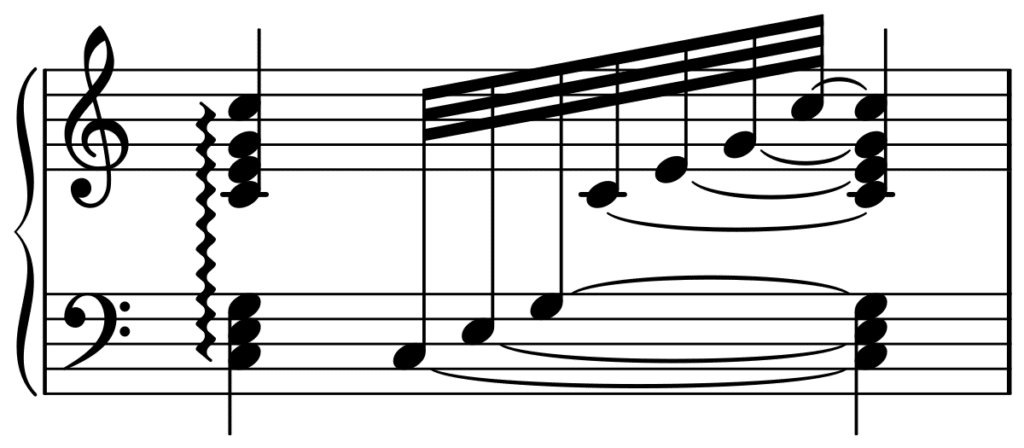
Mordent
The mordent is a melodic variation that indicates that a certain note must be played very quickly by alternating two notes.
The first of these notes is the same as the main note to which the mordent is attached; the second is the higher step. (either by one tone or by a semitone).
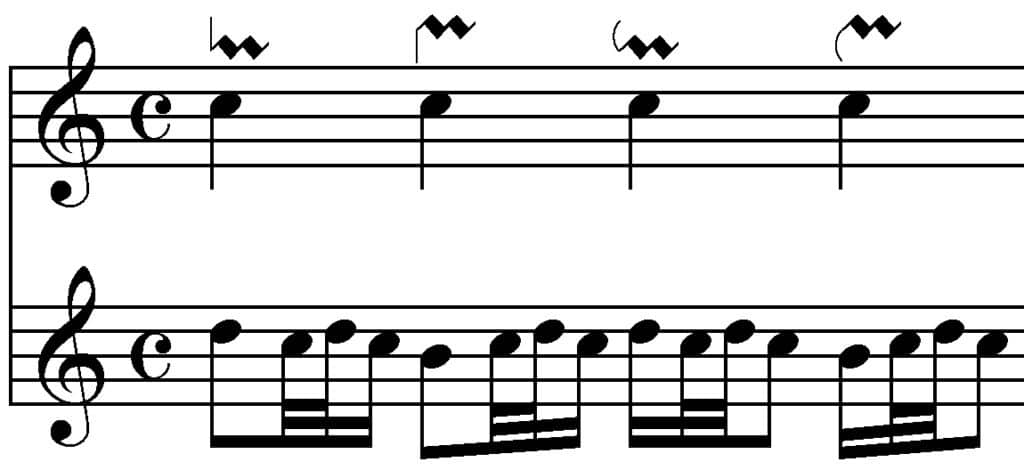
The Mordent should be played cleanly and concisely.
Dynamic nuances
Dynamic or intensity nuances are the different degrees of intensity that one or more notes, a passage or a whole piece of music can go through. They are indicated by signs called regulators and also by Italian terms.
The sound can be weak and strong. The former is indicated by the word "piano" and the latter by the word "forte" expressed.
But "piano" and "forte" can have different degrees of intensity: The more "ffff" they occur, the louder they must be played, and the more "pppp", the quieter the intensity.
The Picatto or Staccato
Staccato is an articulation mark for shortened notes and is represented by a dot above or below the note. Articulation in music is about the way the transition between sounds is made.
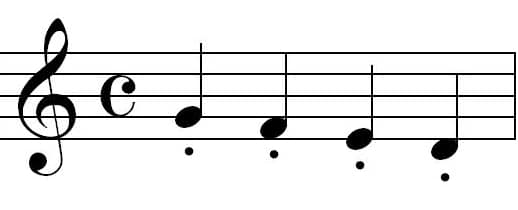
Staccato subtly shortens the note from its original value, and this "staccato" note is separated from the following note by a pause. This short silence has no effect on the volume of the note.





